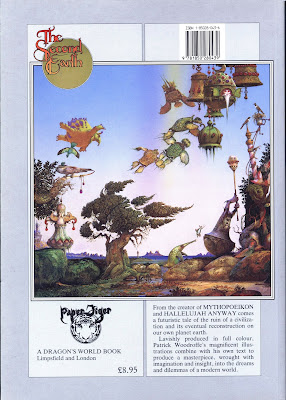by Patrick Woodroffe
Paper Tiger, 1987
'The Second Earth: The Pentateuch Re-Told' (144 pp) was issued by UK publisher Paper Tiger in 1987. Like all books from Paper Tiger, this is a well-made trade paperback with good quality paper stock and good quality reproductions of the artwork.
Patrick Woodroffe (1940 - 2014) was a well-known UK artist whose paintings and mixed-media works are familiar to anyone who read sci-fi and fantasy novels during the 70s.
In 1979 Woodroffe and his friend and colleague, the UK musician David Greenslade, collaborated on a multimedia project called The Pentateuch of the Cosmogony. Greenslade contributed a double album of instrumental music, and Woodroffe, a hardbound book of illustrations. You can listen to the music here.
'The Second Earth' provides an expanded showcase of Woodroffe's artwork for The Pentateuch of the Cosmogony.
The story's premise is one of sci-fi, mixed with mysticism. In 2378 a kilometer-long alien spaceship, labeled the Hermes, is discovered in orbit around Saturn. A UN expedition to the spacecraft discovers it is unmanned. A treasure trove of documents, written in alien script, are found inside the ship; their translation forms the basis of the narrative.
'The Second Earth' relates the mythology and creation tales of the humanoid culture that gave rise to the Hermes. The accompanying artwork is chosen to illustrate various aspects of these creation tales, which are similar in tone to those of ancient cultures here on Earth.
Without disclosing any spoilers, I'll state that as the story progresses, it becomes apparent that the travails of the civilization piloting the Hermes have profound implications for the fate of Mankind and the planet upon which we reside.
'The Second Earth' is something of a disappointment. While Woodroffe's efforts to move beyond being an artist into also being a writer are in some sense to be congratulated, the truth is that his prose is less than inspiring. The main narrative of 'The Second Earth' is obtuse and not very readable.
The Appendix, which details the alien race's cuneiform language, is designed to mimic a scholarly monograph; this is a chore to wade through.
Since no editorial assistance is acknowledged in the book's opening pages, it seems that Woodroffe did not enlist such assistance when writing 'The Second Earth'. If this was indeed the case, it's unfortunate, because editorial oversight likely would have made the book much more coherent and engaging.
The artwork presented in the book certainly is excellent, although having to be cropped or shrunk in order to accommodate the text means that readers over a certain age will likely need glasses in order to make out some of the smaller illustrations, as well as the more intricate details of the larger reproductions.
The verdict ? 'The Second Earth' represents Woodroffe's ambitions to synthesize art, literature, and music into an imaginative new direction; that said, sometimes the transition from artist to writer is not so easily done. 'The Second Earth' succeeds in some degree as a showcase for Woodroffe's artistic talents, but his prose is not up to the task. Given that books like Mythopoeikon and Hallelujah Anyway, which are dedicated solely to Woodroffe's art, are readily available for affordable prices, I really can only recommend 'The Second Earth' to Woodroffe completists.
































































